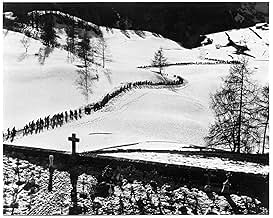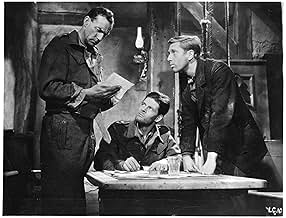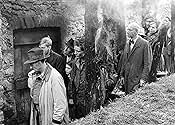अपनी भाषा में प्लॉट जोड़ेंEscaping a Nazi prison train in war-torn Italy, an American and a British soldier set out for the Swiss border and find themselves leading a multi-national party of refugees for the Italian ... सभी पढ़ेंEscaping a Nazi prison train in war-torn Italy, an American and a British soldier set out for the Swiss border and find themselves leading a multi-national party of refugees for the Italian underground.Escaping a Nazi prison train in war-torn Italy, an American and a British soldier set out for the Swiss border and find themselves leading a multi-national party of refugees for the Italian underground.
- पुरस्कार
- कुल 4 जीत
Maurice Sakhnowsky
- Hillel Sokolowski
- (as M. Sakhnowsky)
फ़ीचर्ड समीक्षाएं
"The Last Chance" is a movie about escape and pursuit. It is about Italian villagers helping Jews and Allied POWs escape; and about the Allies helping the Jews as well. The setting for the film was 1943, and the place was northern Italy. This little known film was made in Switzerland and released in Zurich, on May 26, 1945 -- less than three weeks after the end of WWII in Europe. It opened later that year in New York City (Nov. 27), in Brussels (Dec.2), and in Paris (Dec. 19). It appeared in most other European countries in 1946 – but wasn't shown in Italy or Austria until 1947. It was distributed by MGM.
Most of the cast were unknown outside of Europe. The main supporting actors had much more movie experience than any of the three male leads who played the Allied soldiers fleeing the Nazis. Ewart Morris appeared in only one other movie, and John Hoy and Ray Reagan appeared only in this film. Even with their inexperience, the three leads were very good. Characters in the film speak four languages – Italian, English, German and French.
The quality of the film I have is very poor. The movie was obviously made on the cheap, but it is very well done and is an excellent story. Very little costuming or casting was needed of German soldiers. Instead, much of the filming was done of the escapees and villagers helping them. Excellent filming techniques were used. The use of key lighting with lots of shadows reminds one of the early styles used by Alfred Hitchcock and John Ford.
The movie most likely was filmed in Switzerland and part of Italy around Lake Maggiore. This 52,500-acre lake (23,870 hectares) straddles the border of Italy and Switzerland. It was a route frequently used by escaping POWs and downed Allied pilots. Other war movies have been made with escapes by way of Lake Maggiore. At the time of filming, director Leopold Lindtberg would have had no difficulty finding a burned or war- damaged Italian villages in the area. Many locals would be able to serve as extras for the townspeople in the film. These were people who had lived through such treachery and horror within just the past year or two. The film won the grand prize at the Cannes Film Festival in 1946, and earned a Golden Globe in 1947.
"The Last Chance" is a very good war drama from WWII. At the start of the war, Italy was a fascist state and ally of Germany. But the people overthrew Benito Mussolini in 1943. And, throughout the war, Italians aided Jews fleeing the Nazis. They hid and helped American, British and other Allied downed pilots; and they helped escaping POWs. Thousands of Italians were killed by the Germans for aiding escaping Allied soldiers. No other nation during WWII did more to help those fleeing the Nazis. This is a fine movie about that time and effort.
Most of the cast were unknown outside of Europe. The main supporting actors had much more movie experience than any of the three male leads who played the Allied soldiers fleeing the Nazis. Ewart Morris appeared in only one other movie, and John Hoy and Ray Reagan appeared only in this film. Even with their inexperience, the three leads were very good. Characters in the film speak four languages – Italian, English, German and French.
The quality of the film I have is very poor. The movie was obviously made on the cheap, but it is very well done and is an excellent story. Very little costuming or casting was needed of German soldiers. Instead, much of the filming was done of the escapees and villagers helping them. Excellent filming techniques were used. The use of key lighting with lots of shadows reminds one of the early styles used by Alfred Hitchcock and John Ford.
The movie most likely was filmed in Switzerland and part of Italy around Lake Maggiore. This 52,500-acre lake (23,870 hectares) straddles the border of Italy and Switzerland. It was a route frequently used by escaping POWs and downed Allied pilots. Other war movies have been made with escapes by way of Lake Maggiore. At the time of filming, director Leopold Lindtberg would have had no difficulty finding a burned or war- damaged Italian villages in the area. Many locals would be able to serve as extras for the townspeople in the film. These were people who had lived through such treachery and horror within just the past year or two. The film won the grand prize at the Cannes Film Festival in 1946, and earned a Golden Globe in 1947.
"The Last Chance" is a very good war drama from WWII. At the start of the war, Italy was a fascist state and ally of Germany. But the people overthrew Benito Mussolini in 1943. And, throughout the war, Italians aided Jews fleeing the Nazis. They hid and helped American, British and other Allied downed pilots; and they helped escaping POWs. Thousands of Italians were killed by the Germans for aiding escaping Allied soldiers. No other nation during WWII did more to help those fleeing the Nazis. This is a fine movie about that time and effort.
I think that pretty sums up this film.
The other reviews say it very well. And to them, I say "ditto" to those reviews that praise this film. But you want something more specific, don't you? Fair enough.
It's a story of refuges trying to get away from the Nazis, and we begin with a British and American soldier for much of the film, as they make their way into a village. Later, they are joined by a British officer and civilian refuges.
Along with the other characters, we are treated to some very believable people, as three dimensional as you get, and the directing and camera work lets us follow the story, as well as the people and their emotions, in this odyssey.
There are heroics, but these are incredibly believable heroics, and we get the full "motivation" for everything that happens. The camaraderie of the times is beautiful, and is something missing in today's movies.
This is a "smart" movie. Not only do we get awesome intellectually stimulating ideas, drama, and story, but we also get awesome camera, directing, and action. This is well paced, certainly more fluid and active than 95% of the movies that have been made since 1965, if I am to pick a year in which a modern era begins.
Thumbs up. If you get a chance, this is a movie that will excite you on all levels, for all audiences.
The other reviews say it very well. And to them, I say "ditto" to those reviews that praise this film. But you want something more specific, don't you? Fair enough.
It's a story of refuges trying to get away from the Nazis, and we begin with a British and American soldier for much of the film, as they make their way into a village. Later, they are joined by a British officer and civilian refuges.
Along with the other characters, we are treated to some very believable people, as three dimensional as you get, and the directing and camera work lets us follow the story, as well as the people and their emotions, in this odyssey.
There are heroics, but these are incredibly believable heroics, and we get the full "motivation" for everything that happens. The camaraderie of the times is beautiful, and is something missing in today's movies.
This is a "smart" movie. Not only do we get awesome intellectually stimulating ideas, drama, and story, but we also get awesome camera, directing, and action. This is well paced, certainly more fluid and active than 95% of the movies that have been made since 1965, if I am to pick a year in which a modern era begins.
Thumbs up. If you get a chance, this is a movie that will excite you on all levels, for all audiences.
This is a wonderful movie. The copy I saw was not good, but that did not detract from the emotional and realistic story. It provides, as much as anything can, what seems to be a legitimate sense of the desperation that these refugees must have felt as they were driven from their homes by the war around them. Exceptional story in a raw but effective production.
In the chaos surrounding the Italian campaign, an American flier and a British officer meet after having escaped internment. They make their way north towards Switzerland. They are aided by ordinary people. When news comes that Mussolini has escaped the partisans, a local Fascist rats them out to the Germans and they have to make a run for it over the wintry mountains, leading a desperate band of refugees.
This Swiss movie was directed and co-written by Leopold Lindtberg. He knew something about being a refugee. He began his career in the theater and the movies in his native Vienna, but in the early 1940s, his Jewish religion forced him to flee to Switzerland. By chance he was able to cast this movie well: two of the "escaped British officers" were precisely that, and professional actors to boot; the American was a flier whose plane came down in Switzerland, and was being held there until matters could be sorted out.
Although there are dramatic, theatrical moments, the setting in the mountains and towns of Switzerland, and the casting of locals lends a humanist air to the movie that made me think of Pressberger & Powell's movies of the period. the camerawork is extraordinary; instead of using rapid cutting to create excitement, cinematographer Emil Berna uses a moving camera, with fast, long movements to produce a sense of panic.
Although this sort of movie was almost a commonplace of the era, it's ANABASIS-like plot of trying to escape -- only this time, it's to Switzerland, instead of the sea -- and its fortuitous casting makes it extraordinary.
This Swiss movie was directed and co-written by Leopold Lindtberg. He knew something about being a refugee. He began his career in the theater and the movies in his native Vienna, but in the early 1940s, his Jewish religion forced him to flee to Switzerland. By chance he was able to cast this movie well: two of the "escaped British officers" were precisely that, and professional actors to boot; the American was a flier whose plane came down in Switzerland, and was being held there until matters could be sorted out.
Although there are dramatic, theatrical moments, the setting in the mountains and towns of Switzerland, and the casting of locals lends a humanist air to the movie that made me think of Pressberger & Powell's movies of the period. the camerawork is extraordinary; instead of using rapid cutting to create excitement, cinematographer Emil Berna uses a moving camera, with fast, long movements to produce a sense of panic.
Although this sort of movie was almost a commonplace of the era, it's ANABASIS-like plot of trying to escape -- only this time, it's to Switzerland, instead of the sea -- and its fortuitous casting makes it extraordinary.
"The Last Chance" is a production by the European branch of MGM and has a most unusual cast. None of the actors are particularly famous and they speak many different languages.
The film is set in Italy just after the ouster of Mussolini. The country is excited to see the Fascist regime go...and for two stranded soldiers, an American and British one, who are thrilled that they can finally relax and not worry about being captured. However, their joy is very short-lived, as the Germans soon pour into the country and they take control. Now the two men need to be on their guards again. Along the way, they meet many lovely Italians who assist them as well as many other refugees seeking freedom in nearby Switzerland. What's to become of all these displaced people?
The movie came out about six months after the war in Europe had ended and it brings attention to refugees...who were seldom talked about in movies of the day. Well written, compelling and worth seeing.
The film is set in Italy just after the ouster of Mussolini. The country is excited to see the Fascist regime go...and for two stranded soldiers, an American and British one, who are thrilled that they can finally relax and not worry about being captured. However, their joy is very short-lived, as the Germans soon pour into the country and they take control. Now the two men need to be on their guards again. Along the way, they meet many lovely Italians who assist them as well as many other refugees seeking freedom in nearby Switzerland. What's to become of all these displaced people?
The movie came out about six months after the war in Europe had ended and it brings attention to refugees...who were seldom talked about in movies of the day. Well written, compelling and worth seeing.
क्या आपको पता है
- ट्रिवियाThe three leads were all real prisoners of war who had escaped to Switzerland, and were asked by the director Leopold Lindtberg to be in the film. Ewart G. Morrison (Maj. Telford) even wore the clothes he had escaped in as his costume.
- साउंडट्रैकFrère Jacques
Traditional
Sung by the party in the mountain hut
टॉप पसंद
रेटिंग देने के लिए साइन-इन करें और वैयक्तिकृत सुझावों के लिए वॉचलिस्ट करें
विवरण
- रिलीज़ की तारीख़
- कंट्री ऑफ़ ओरिजिन
- आधिकारिक साइट
- भाषाएं
- इस रूप में भी जाना जाता है
- The Last Chance
- फ़िल्माने की जगहें
- उत्पादन कंपनी
- IMDbPro पर और कंपनी क्रेडिट देखें
- चलने की अवधि1 घंटा 53 मिनट
- रंग
- ध्वनि मिश्रण
- पक्ष अनुपात
- 1.37 : 1
इस पेज में योगदान दें
किसी बदलाव का सुझाव दें या अनुपलब्ध कॉन्टेंट जोड़ें



























